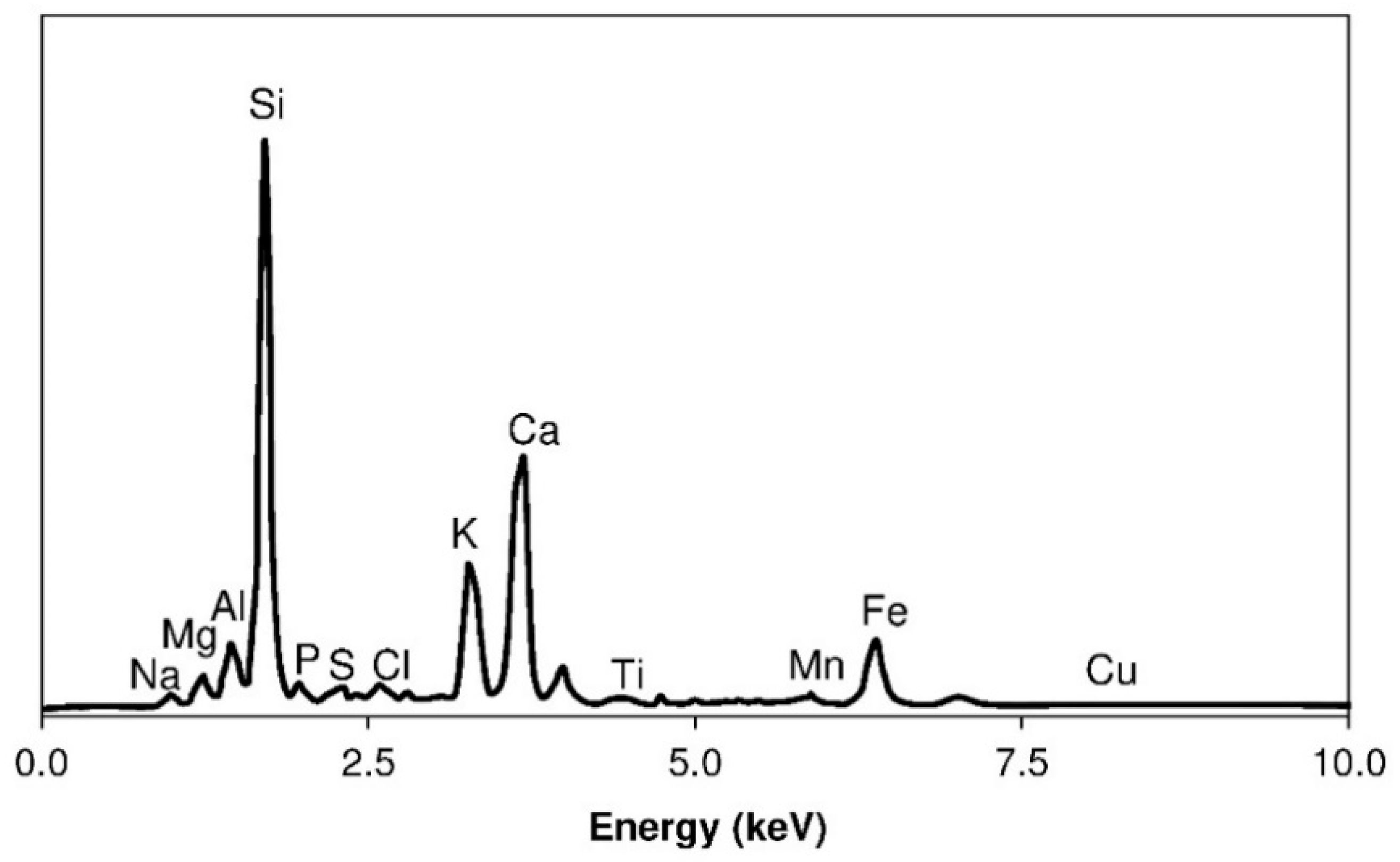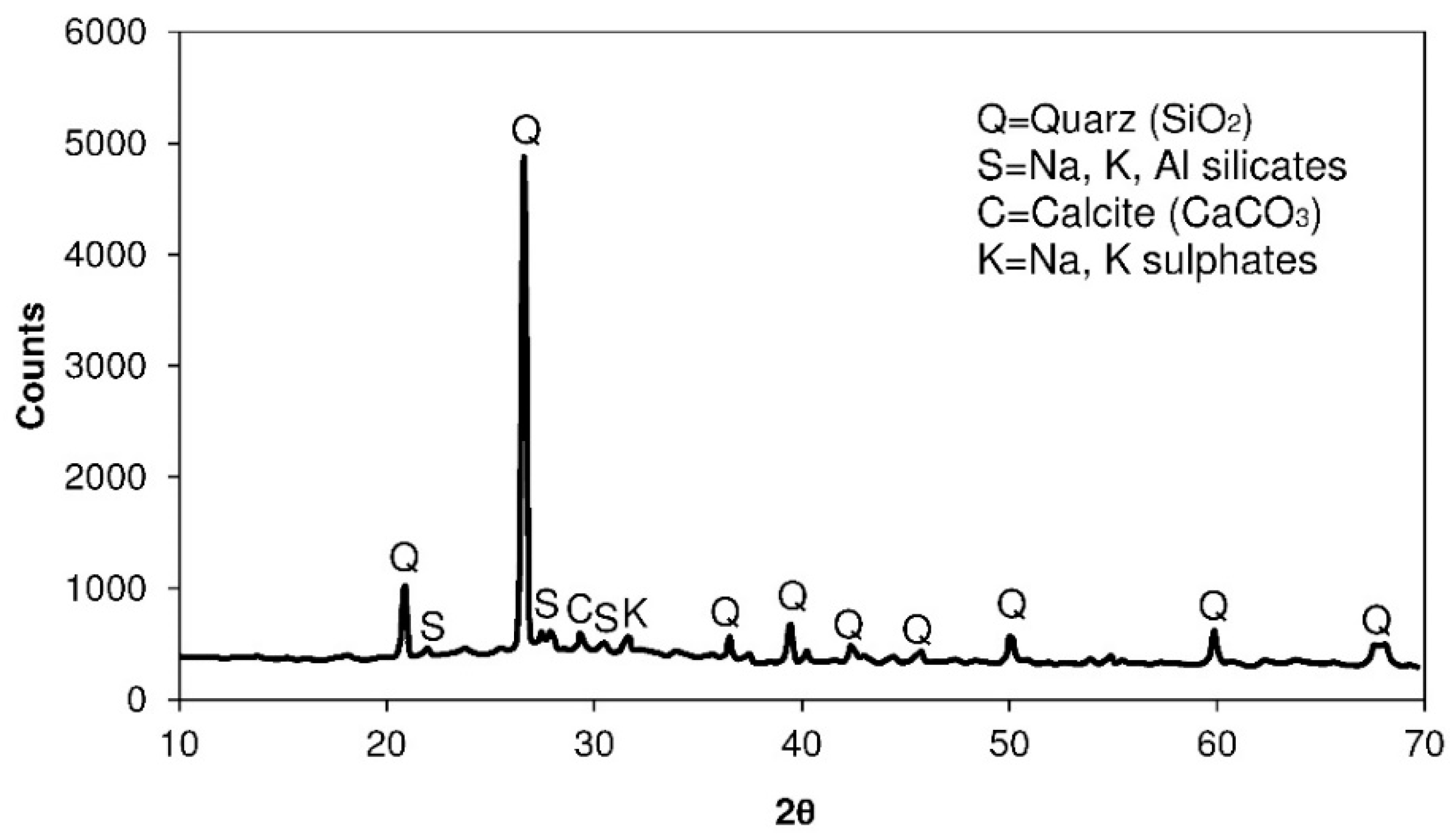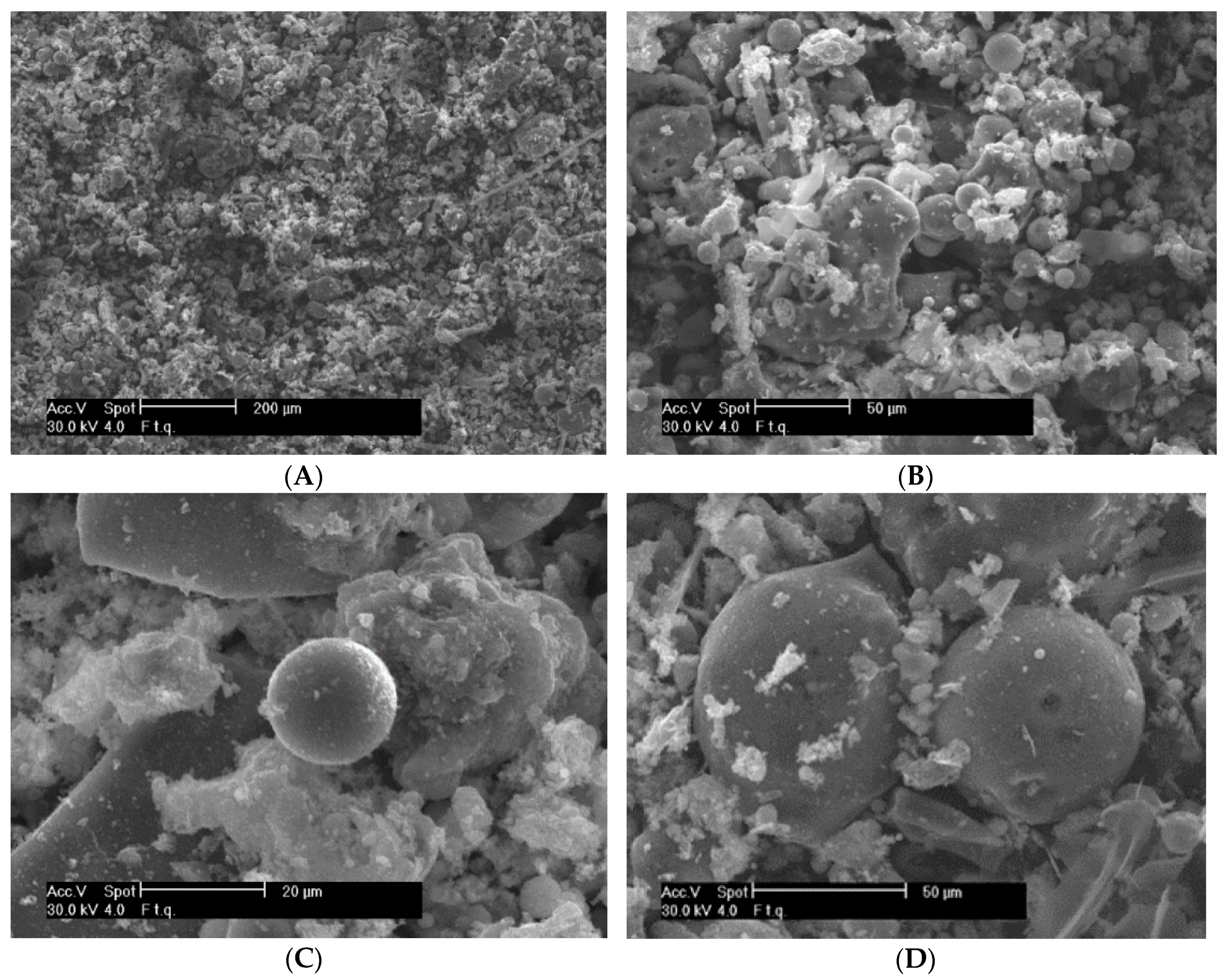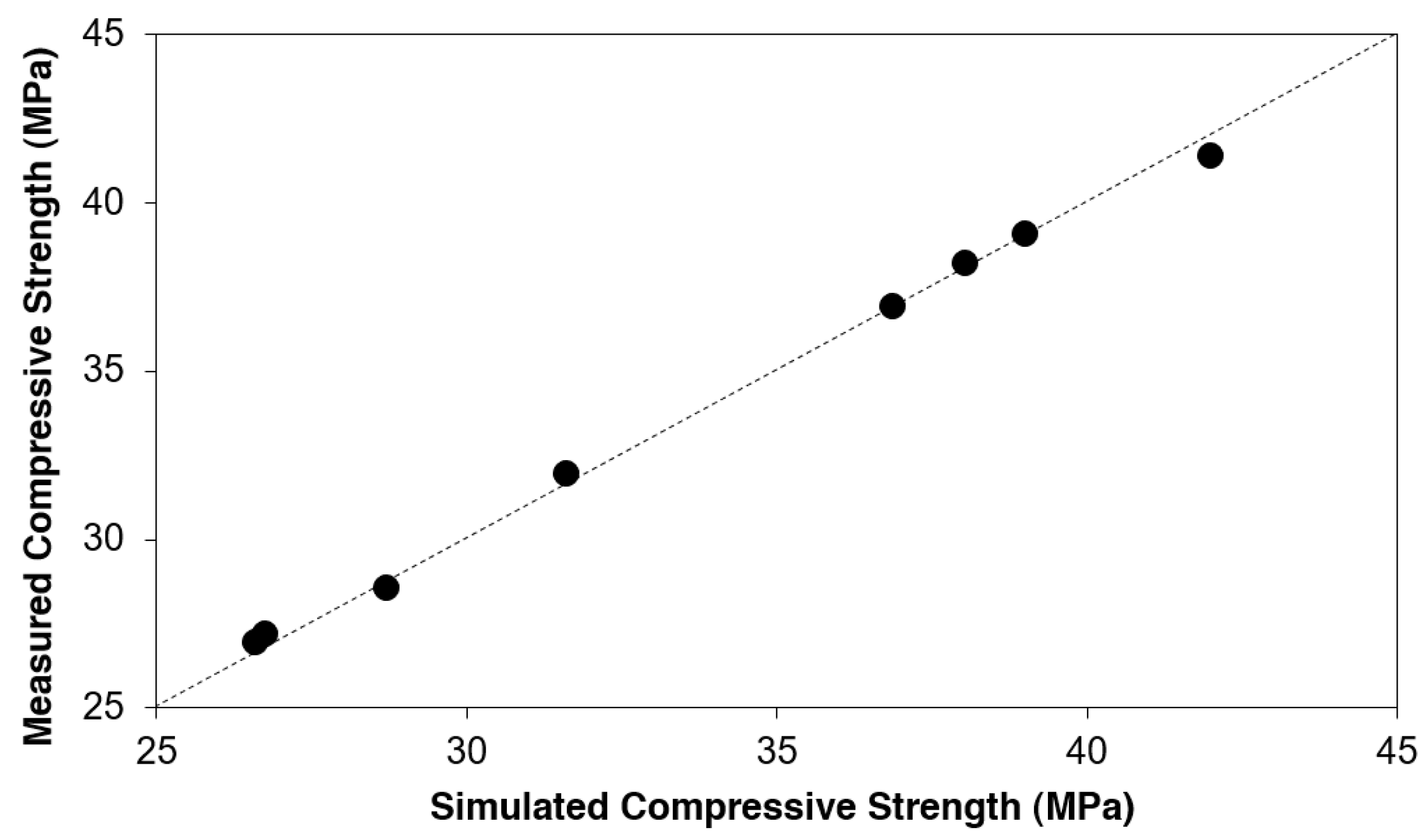Compressive Strength and Leaching Behavior of Mortars with Biomass Ash
Abstract
:1. Introduction
- (1)
- the reduction of the cement content;
- (2)
- the use of fly ash as a raw material, instead of disposing of it;
- (3)
- the improvement of the concrete durability properties;
- (4)
- a better workability of the concrete mix.
2. Materials and Methods
2.1. Specimens Preparation and Procedure
2.2. Compressive Strength
2.3. Micro-Structural, Chemical and Physical Ash Characterization
2.4. Heavy Metal Leaching Tests
3. Results and Discussion
Heavy Metal Leaching Tests
4. Conclusions
Author Contributions
Funding
Conflicts of Interest
References
- Kaltschmitt, M.; Lenz, V.; Thrän, D. Zur energetischen Nutzung von Biomasse in Deutschland—Potenziale, Stand und Perspektiven. Lifis Online 2008, 1–12. Available online: https://www.leibniz-institut.de/archiv/kaltschmitt_25_04_08.pdf (accessed on 30 January 2018).
- Li, K.-Y.; Huang, X.; Fleischmann, C.; Rein, G.; Ji, J. Pyrolysis of Medium-Density Fiberboard: Optimized Search for Kinetics Scheme and Parameters via a Genetic Algorithm Driven by Kissinger’s Method. Energy Fuels 2014, 28, 6130–6139. [Google Scholar] [CrossRef] [Green Version]
- Thrän, D.; Weber, M.; Scheuermann, A.; Fröhlich, N.; Zeddies, J.; Henze, A.; Thoroe, C.; Schweinle, J.; Fritsche, U.R.; Jenseit, W.; et al. Sustainable Strategies for Biomass Use in the European Context. Analysis in the Charged Debate on National Guidelines and the Competition between Solid, Liquid and Gaseous Biofuels. Available online: https://www.dbfz.de/fileadmin/user_upload/Referenzen/Studien/Biohandel_Studie_IE.pdf (accessed on 30 January 2018).
- Fudala-Ksiazek, S.; Pierpaoli, M.; Kulbat, E.; Luczkiewicz, A. A modern solid waste management strategy—The generation of new by-products. Waste Manag. 2016, 49, 516–529. [Google Scholar] [CrossRef] [PubMed]
- Demirbaş, A. Heavy Metal Contents of Fly Ashes from Selected Biomass Samples. Energy Sour. 2005, 27, 1269–1276. [Google Scholar] [CrossRef]
- James, A.; Thring, R.; Helle, S.; Ghuman, H.; James, A.K.; Thring, R.W.; Helle, S.; Ghuman, H.S. Ash Management Review-Applications of Biomass Bottom Ash. Energies 2012, 5, 3856–3873. [Google Scholar] [CrossRef]
- Schneider, G.C.; Hartmann, H. Maize as Energy Crop for Combustion. Available online: http://www.tfz.bayern.de/mam/cms08/festbrennstoffe/dateien/09_bericht.pdf (accessed on 30 January 2018).
- Hartmann, H.; Böhm, T.; Maier, L. Naturbelassene biogene Festbrennstoffe—Umweltrelevante Eigenschaften und Einflussmöglichkeiten. Available online: https://www.lfu.bayern.de/energie/biogene_festbrennstoffe/doc/festbrennstoffe.pdf (accessed on 30 January 2017).
- Giosuè, C.; Pierpaoli, M.; Mobili, A.; Ruello, M.L.; Tittarelli, F. Influence of binders and lightweight aggregates on the properties of cementitious mortars: From traditional requirements to indoor air quality improvement. Materials 2017, 10, 978. [Google Scholar] [CrossRef] [PubMed]
- Pierpaoli, M.; Fava, G. A passive opportunity for improving air quality in the schools environment: A real-world scale testing. Am. J. Environ. Sci. 2016, 12, 206–212. [Google Scholar] [CrossRef]
- Pierpaoli, M.; Forconi, D.; Monosi, S.; Ruello, M.L. Activated carbon cloth as aggregate for special mortars. In Proceedings of the XIV Convegno Nazionale AIMAT 2017, Ischia Porto, Italy, 12–15 July 2017. [Google Scholar]
- Mobili, A.; Giosuè, C.; Tittarelli, F. Valorisation of GRP Dust Waste in Fired Clay Bricks. Adv. Civ. Eng. 2018, 2018, 5256741. [Google Scholar] [CrossRef]
- Chen, Q.Y.; Tyrer, M.; Hills, C.D.; Yang, X.M.; Carey, P. Immobilisation of heavy metal in cement-based solidification/stabilisation: A review. Waste Manag. 2009, 29, 390–403. [Google Scholar] [CrossRef] [PubMed]
- Campos Silva, H.; Garces Terradillos, P.; Zornoza, E.; Mendoza-Rangel, J.; Castro-Borges, P.; Juarez Alvarado, C.; Campos Silva, H.G.; Garces Terradillos, P.; Zornoza, E.; Mendoza-Rangel, J.M.; et al. Improving Sustainability through Corrosion Resistance of Reinforced Concrete by Using a Manufactured Blended Cement and Fly Ash. Sustainability 2018, 10, 2004. [Google Scholar] [CrossRef]
- Yazıcı, H. The effect of silica fume and high-volume Class C fly ash on mechanical properties, chloride penetration and freeze–thaw resistance of self-compacting concrete. Constr. Build. Mater. 2008, 22, 456–462. [Google Scholar] [CrossRef]
- Collepardi, M.; Monosi, S.; Valenti, M. Optimization of Superplasticizer Type and Dosage in Fly Ash and Silica Fume Concretes. Spec. Publ. 1989, 119, 425–444. [Google Scholar] [CrossRef]
- Tittarelli, F.; Mobili, A.; Giosuè, C.; Belli, A.; Bellezze, T. Corrosion behaviour of bare and galvanized steel in geopolymer and Ordinary Portland Cement based mortars with the same strength class exposed to chlorides. Corros. Sci. 2018, 134, 64–77. [Google Scholar] [CrossRef]
- Coppola, L.; Coffetti, D.; Crotti, E.; Coppola, L.; Coffetti, D.; Crotti, E. Plain and Ultrafine Fly Ashes Mortars for Environmentally Friendly Construction Materials. Sustainability 2018, 10, 874. [Google Scholar] [CrossRef]
- Collivignarelli, C.; Sorlini, S. Reuse of municipal solid wastes incineration fly ashes in concrete mixtures. Waste Manag. 2002, 22, 909–912. [Google Scholar] [CrossRef]
- Siddique, R. Use of municipal solid waste ash in concrete. Resour. Conserv. Recycl. 2010, 55, 83–91. [Google Scholar] [CrossRef]
- Smol, M.; Kulczycka, J.; Henclik, A.; Gorazda, K.; Wzorek, Z. The possible use of sewage sludge ash (SSA) in the construction industry as a way towards a circular economy. J. Clean. Prod. 2015, 95, 45–54. [Google Scholar] [CrossRef]
- Cyr, M.; Coutand, M.; Clastres, P. Technological and environmental behavior of sewage sludge ash (SSA) in cement-based materials. Cem. Concr. Res. 2007, 37, 1278–1289. [Google Scholar] [CrossRef]
- Memon, S.; Wahid, I.; Khan, M.; Tanoli, M.; Bimaganbetova, M.; Memon, S.A.; Wahid, I.; Khan, M.K.; Tanoli, M.A.; Bimaganbetova, M. Environmentally Friendly Utilization of Wheat Straw Ash in Cement-Based Composites. Sustainability 2018, 10, 1322. [Google Scholar] [CrossRef]
- Cruz-Yusta, M.; Mármol, I.; Morales, J.; Sánchez, L. Use of olive biomass fly ash in the preparation of environmentally friendly mortars. Environ. Sci. Technol. 2011, 45, 6991–6996. [Google Scholar] [CrossRef] [PubMed]
- Fava, G.; Naik, T.; Moriconi, G. Properties of Cementitious Paste Made with Cement and Ash from Olive Waste. Available online: http://www.cbu-uwm.info/Papers/2011%20CBU%20Reports/CBU-2011-02.pdf (accessed on 25 February 2011).
- Fava, G.; Ruello, M.L.; Corinaldesi, V. Paper Mill Sludge Ash as Supplementary Cementitious Material. J. Mater. Civ. Eng. 2011, 23, 772–776. [Google Scholar] [CrossRef] [Green Version]
- Wang, S.; Baxter, L. Comprehensive study of biomass fly ash in concrete: Strength, microscopy, kinetics and durability. Fuel Process. Technol. 2007, 88, 1165–1170. [Google Scholar] [CrossRef]
- Cheah, C.B.; Ramli, M. The implementation of wood waste ash as a partial cement replacement material in the production of structural grade concrete and mortar: An overview. Resour. Conserv. Recycl. 2011, 55, 669–685. [Google Scholar] [CrossRef]
- Dwivedi, V.N.; Singh, N.P.; Das, S.S.; Singh, N.B. A new pozzolanic material for cement industry: Bamboo leaf ash. Int. J. Phys. Sci. 2006, 1, 106–111. [Google Scholar]
- Naik, T.R.; Singh, S.S.; Ramme, B.W. Performance and leaching assessment of flowable slurry. J. Environ. Eng. 2001, 127, 359–368. [Google Scholar] [CrossRef]
- UNI EN 1015-3:2007. Methods of Test for Mortar For Masonry—Part 3: Determination of Consistence of Fresh Mortar (by Flow Table); Ente di Unificazione Nazionale Italiano: Milan, Italy, 2007. [Google Scholar]
- Ministero Dell’ambiente DECRETO MINISTERIALE 5 Febbraio 1998, Allegato 1 1998. Available online: http://www.gazzettaufficiale.it/eli/id/1998/04/16/098A3052/sg%20 (accessed on 30 January 2017).
- ASTM International. ASTM C1220-10—Standard Test Method for Static Leaching of Monolithic Waste Forms for Disposal of Radioactive Waste; ASTM: West Conshohocken, PA, USA, 2010. [Google Scholar]
- ISO/TC 85/SC. ISO 6961:1982 Long-Term Leach Testing of Solidified Radioactive Waste Forms; ISO: Geneva, Switzerland, 1982. [Google Scholar]
- The Center for By-Products Utilization. Available online: http://www.cbu-uwm.info (accessed on 30 January 2017).
- Naik, T.R. In-Place Concrete Strength Determination by the Maturity Method. ASCE J. Eng. Mech. Div. 1980, 105, 465–480. [Google Scholar]
- Neville, A. Properties of Concrete; Longman: London, UK, 1995. [Google Scholar]
- Hemalatha, T.; Ramaswamy, A. A review on fly ash characteristics—Towards promoting high volume utilization in developing sustainable concrete. J. Clean. Prod. 2017, 147, 546–559. [Google Scholar] [CrossRef]





| Element | Corn, Whole Plant [7] [mg/kg d. b.] | Coniferous Wood [8] [mg/kg d. b.] | Grain Straw [8] [mg/kg d. b.] |
|---|---|---|---|
| Chrome | 4.85 | 4.50 | 4.62 |
| Cobalt | 0.23 | 0.35 | 0.14 |
| Copper | 6.08 | 3.45 | 2.21 |
| Manganese | 46.25 | 344.70 | 22.00 |
| Molybdenum | 2.53 | 1.12 | 0.38 |
| Nickel | 0.62 | 4.23 | 0.69 |
| Zinc | 50.08 | 37.64 | 9.42 |
| Units | Na | Mg | Al | Si | P | S | Cl | K | Ca | Fe |
|---|---|---|---|---|---|---|---|---|---|---|
| % | 5.62 | 3.96 | 8.20 | 39.94 | 3.31 | 6.03 | 2.63 | 7.09 | 16.52 | 5.02 |
| w/cm = 0.42 | w/cm = 0.50 | |||||||
|---|---|---|---|---|---|---|---|---|
| WCSA | Water (mL) | CEM II/A-L 32.5R | Ash (g) | Sand (g) | Water (mL) | CEM II/A-L 32.5R | Ash (g) | Sand (g) |
| 0 | 189 | 450 | 0 | 1350 | 227 | 450 | 0 | 1426 |
| 10% | 193 | 405 | 54 | 1350 | 244 | 405 | 45.2 | 1426 |
| 20% | 197 | 360 | 108 | 1350 | 262 | 360 | 90.4 | 1426 |
| 30% | 200 | 315 | 152 | 1350 | 280 | 315 | 135.5 | 1426 |
| WCSA | w/cm | Average Diameter (cm) | w/cm | Average Diameter (cm) |
|---|---|---|---|---|
| 0 | 0.42 | 13 | 0.5 | 14 |
| 10% | 0.42 | 13 | 0.5 | 16 |
| 20% | 0.42 | 13 | 0.5 | 18 |
| 30% | 0.42 | 13 | 0.5 | 19 |
| Age Days | w/cm = 0.42 | w/cm = 0.50 | ||||||
|---|---|---|---|---|---|---|---|---|
| Control | 10% | 20% | 30% | Control | 10% | 20% | 30% | |
| 3 | 28.0 | 26.4 | 26.6 | 23.3 | 22.0 | 17.8 | 14.6 | 14.9 |
| 7 | 32.5 | 35.0 | 32.3 | 25.6 | 27.4 | 21.3 | 17.6 | 19.4 |
| 28 | 38.4 | 38.8 | 36.7 | 37.2 | 30.6 | 27.9 | 25.2 | 26.7 |
| 56 | 38.7 | 40.0 | 37.2 | 37.3 | 31.4 | 28.2 | 25.7 | 27.6 |
| w/cm = 0.42 | w/cm = 0.50 | |||
|---|---|---|---|---|
| Sample Ash% | 1/b1 (-) | 1/a1 (MPa) | 1/a1 (-) | 1/a1 (MPa) |
| 0 | 0.047 | 39.1 | 0.031 | 31.9 |
| 10 | 0.036 | 41.4 | 0.022 | 27.4 |
| 20 | 0.036 | 40.3 | 0.014 | 25.1 |
| 30 | 0.022 | 38.6 | 0.013 | 28.6 |
| WCSA | Ba | Cr | Cu | Ni | Pb | V | Zn |
|---|---|---|---|---|---|---|---|
| 0 | 0.087 | 0.008 | 0.042 | 0.004 | 0.003 | 0.008 | 0.128 |
| 10% | 0.082 | 0.007 | 0.008 | 0.002 | 0.002 | 0.011 | 0.113 |
| 20% | 0.049 | 0.005 | 0.009 | 0.005 | 0.001 | 0.007 | 0.386 |
| 30% | 0.285 | 0.006 | 0.013 | 0.004 | 0.001 | 0.015 | 0.001 |
| 0 | 0.272 | 0.008 | 0.019 | 0.003 | 0.002 | 0.012 | 0.001 |
| 10% | 0.079 | 0.026 | 0.037 | 0.007 | 0.005 | 0.026 | 0.116 |
| 20% | 0.034 | 0.011 | 0.015 | 0.006 | 0.002 | 0.026 | 0.001 |
| 30% | 0.143 | 0.008 | 0.011 | 0.008 | 0.003 | 0.010 | 0.298 |
| ref. limit | 1.0 | 0.05 | 0.05l | 0.01 | 0.05 | 0.25 | 3.0 |
| w/cm = 0.42 | w/cm = 0.50 | |||
|---|---|---|---|---|
| Sample ash | 1/b1 (-) | 1/a1 (meq Ca) | 1/b1 (-) | 1/a1 (meq Ca) |
| 0 | 0.094 | 10.58 | 0.049 | 20.31 |
| 10% | 0.073 | 13.61 | 0.062 | 16.04 |
| 20% | 0.124 | 8.06 | 0.075 | 13.23 |
| 30% | 0.183 | 5.45 | 0.074 | 13.41 |
© 2018 by the authors. Licensee MDPI, Basel, Switzerland. This article is an open access article distributed under the terms and conditions of the Creative Commons Attribution (CC BY) license (http://creativecommons.org/licenses/by/4.0/).
Share and Cite
Fava, G.; Naik, T.R.; Pierpaoli, M. Compressive Strength and Leaching Behavior of Mortars with Biomass Ash. Recycling 2018, 3, 46. https://doi.org/10.3390/recycling3030046
Fava G, Naik TR, Pierpaoli M. Compressive Strength and Leaching Behavior of Mortars with Biomass Ash. Recycling. 2018; 3(3):46. https://doi.org/10.3390/recycling3030046
Chicago/Turabian StyleFava, Gabriele, Tarun R. Naik, and Mattia Pierpaoli. 2018. "Compressive Strength and Leaching Behavior of Mortars with Biomass Ash" Recycling 3, no. 3: 46. https://doi.org/10.3390/recycling3030046






